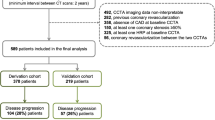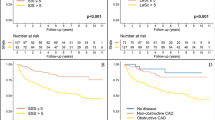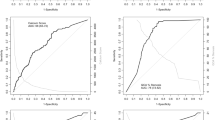Abstract
To determine whether the assessment of individual plaques is superior in predicting the progression to obstructive coronary artery disease (CAD) on serial coronary computed tomography angiography (CCTA) than per-patient assessment. From a multinational registry of 2252 patients who underwent serial CCTA at a ≥ 2-year inter-scan interval, patients with only non-obstructive lesions at baseline were enrolled. CCTA was quantitatively analyzed at both the per-patient and per-lesion level. Models predicting the development of an obstructive lesion at follow up using either the per-patient or per-lesion level CCTA measures were constructed and compared. From 1297 patients (mean age 60 ± 9 years, 43% men) enrolled, a total of 3218 non-obstructive lesions were identified at baseline. At follow-up (inter-scan interval: 3.8 ± 1.6 years), 76 lesions (2.4%, 60 patients) became obstructive, defined as > 50% diameter stenosis. The C-statistics of Model 1, adjusted only by clinical risk factors, was 0.684. The addition of per-patient level total plaque volume (PV) and the presence of high-risk plaque (HRP) features to Model 1 improved the C-statistics to 0.825 [95% confidence interval (CI) 0.823–0.827]. When per-lesion level PV and the presence of HRP were added to Model 1, the predictive value of the model improved the C-statistics to 0.895 [95% CI 0.893–0.897]. The model utilizing per-lesion level CCTA measures was superior to the model utilizing per-patient level CCTA measures in predicting the development of an obstructive lesion (p < 0.001). Lesion-level analysis of coronary atherosclerotic plaques with CCTA yielded better predictive power for the development of obstructive CAD than the simple quantification of total coronary atherosclerotic burden at a per-patient level.
Clinical Trial Registration: ClinicalTrials.gov NCT0280341

Similar content being viewed by others
Data availability
The data that support the findings of this study are available from the corresponding author, upon reasonable request.
Code availability
The relevant SAS and R codes for the statistical analysis are available from the corresponding author, upon reasonable request.
References
Franco M, Cooper RS, Bilal U, Fuster V (2011) Challenges and opportunities for cardiovascular disease prevention. Am J Med 124(2):95–102
Perk J, De Backer G, Gohlke H et al (2012) European guidelines on cardiovascular disease prevention in clinical practice (version 2012). Eur Heart J 33(13):1635–1701
Goff DC, Lloyd-Jones DM, Bennett G et al (2014) 2013 ACC/AHA guideline on the assessment of cardiovascular risk: a report of the American College of Cardiology/American Heart Association task force on practice guidelines. J Am Coll Cardiol 63(25_PA):2935–2959
Lee SE, Sung JM, Rizvi A et al (2018) Quantification of coronary atherosclerosis in the assessment of coronary artery disease. Circ Cardiovasc Imaging 11(7):e007562
Motoyama S, Sarai M, Harigaya H et al (2009) Computed tomographic angiography characteristics of atherosclerotic plaques subsequently resulting in acute coronary syndrome. J Am Coll Cardiol 54(1):49–57
Kini AS, Baber U, Kovacic JC et al (2013) Changes in plaque lipid content after short-term intensive versus standard statin therapy: the YELLOW trial (reduction in yellow plaque by aggressive lipid-lowering therapy). J Am Coll Cardiol 62(1):21–29
Chang HJ, Lin FY, Lee SE et al (2018) Coronary atherosclerotic precursors of acute coronary syndromes. J Am Coll Cardiol 71(22):2511–2522
Naghavi M, Libby P, Falk E et al (2003) From vulnerable plaque to vulnerable patient: a call for new definitions and risk assessment strategies: Part I. Circulation 108(14):1664–1672
Arbab-Zadeh A, Fuster V (2015) The myth of the “vulnerable plaque”: transitioning from a focus on individual lesions to atherosclerotic disease burden for coronary artery disease risk assessment. J Am Coll Cardiol 65(8):846–855
Lee SE, Chang HJ, Rizvi A et al (2016) Rationale and design of the Progression of AtheRosclerotic PlAque DetermIned by Computed TomoGraphic Angiography IMaging (PARADIGM) registry: a comprehensive exploration of plaque progression and its impact on clinical outcomes from a multicenter serial coronary computed tomographic angiography study. Am Heart J 182:72–79
Abbara S, Blanke P, Maroules CD et al (2016) SCCT guidelines for the performance and acquisition of coronary computed tomographic angiography: a report of the society of cardiovascular computed tomography guidelines committee: endorsed by the North American Society for Cardiovascular Imaging (NASCI). J Cardiovasc Comput Tomogr 10(6):435–449
Leipsic J, Abbara S, Achenbach S et al (2014) SCCT guidelines for the interpretation and reporting of coronary CT angiography: a report of the society of cardiovascular computed tomography guidelines committee. J Cardiovasc Comput Tomogr 8(5):342–358
Park HB, Lee BK, Shin S et al (2015) Clinical feasibility of 3D automated coronary atherosclerotic plaque quantification algorithm on coronary computed tomography angiography: comparison with intravascular ultrasound. Eur Radiol 25(10):3073–3083
Lee SE, Chang HJ, Sung JM et al (2018) Effects of statins on coronary atherosclerotic plaques: the PARADIGM (Progression of AtheRosclerotic PlAque DetermIned by Computed TomoGraphic Angiography Imaging) Study. JACC Cardiovasc Imaging. https://doi.org/10.1016/j.jcmg.2018.04.015
Motoyama S, Ito H, Sarai M et al (2015) Plaque characterization by coronary computed tomography angiography and the likelihood of acute coronary events in mid-term follow-up. J Am Coll Cardiol 66(4):337–346
Papadopoulou SL, Neefjes LA, Garcia-Garcia HM et al (2012) Natural history of coronary atherosclerosis by multislice computed tomography. JACC Cardiovasc Imaging 5(3s1):S28–37
Task Force M, Montalescot G, Sechtem U et al (2013) 2013 ESC guidelines on the management of stable coronary artery disease: the task force on the management of stable coronary artery disease of the European Society of Cardiology. Eur Heart J 34(38):2949–3003
Puchner SB, Liu T, Mayrhofer T et al (2014) High-risk plaque detected on coronary CT angiography predicts acute coronary syndromes independent of significant stenosis in acute chest pain: results from the ROMICAT-II trial. J Am Coll Cardiol 64(7):684–692
Hernan MA, Brumback B, Robins JM (2000) Marginal structural models to estimate the causal effect of zidovudine on the survival of HIV-positive men. Epidemiology 11(5):561–570
Vickers AJ, Cronin AM, Begg CB (2011) One statistical test is sufficient for assessing new predictive markers. BMC Med Res Methodol 11(1):1
DeLong ER, DeLong DM, Clarke-Pearson DL (1988) Comparing the areas under two or more correlated receiver operating characteristic curves: a nonparametric approach. Biometrics 44:837–845
Pencina MJ, D'Agostino RB (2004) Overall C as a measure of discrimination in survival analysis: model specific population value and confidence interval estimation. Stat Med 23(13):2109–2123
Kubo T, Maehara A, Mintz GS et al (2010) The dynamic nature of coronary artery lesion morphology assessed by serial virtual histology intravascular ultrasound tissue characterization. J Am Coll Cardiol 55(15):1590–1597
Tian J, Dauerman H, Toma C et al (2014) Prevalence and characteristics of TCFA and degree of coronary artery stenosis: an OCT, IVUS, and angiographic study. J Am Coll Cardiol 64(7):672–680
Maehara A, Stone GW (2017) High-risk coronary atherosclerosis: is it the plaque burden, the calcium, the lipid, or something else? Circ Cardiovasc Imaging. https://doi.org/10.1161/CIRCIMAGING.117.007116
Ghanem AM, Hamimi AH, Matta JR et al (2019) Automatic coronary wall and atherosclerotic plaque segmentation from 3D coronary CT angiography. Sci Rep 9(1):47
Funding
This work was supported by the Leading Foreign Research Institute Recruitment Program through the National Research Foundation (NRF) of Korea funded by the Ministry of Science and ICT (MSIT) (Grant No. 2012027176) and Institute for Information & communications Technology Promotion(IITP) grant funded by the Korea government(MSIT) (No.2018-0-00861, Intelligent SW Technology Development for Medical Data Analysis). The study was also funded in part by a generous gift from the Dalio Institute of Cardiovascular Imaging and the Michael Wolk Foundation. The funders of the study had no role in study design, data collection, data analysis, data interpretation, or writing of the report. The corresponding author had full access to all the data in the study and had final responsibility for the decision to submit the manuscript for publication.
Author information
Authors and Affiliations
Contributions
All authors contributed to the data collection. Study conception and design were performed by Dr.Hyuk-Jae Chang, and Dr.Sang-Eun Lee. Material preparation and analysis were performed by Dr.Ji Min Sung and Dr.Sang-Eun Lee. The first draft of the manuscript was written by Dr.Sang-Eun Lee and all authors commented on previous versions of the manuscript. All authors read and approved the final manuscript.
Corresponding author
Ethics declarations
Conflict of interest
Dr. Chang receives funding from the Leading Foreign Research Institute Recruitment Program through the National Research Foundation (NRF) of Korea funded by the Ministry of Science and ICT (MSIT) (Grant No. 2012027176). Dr. James K. Min receives funding from the Dalio Foundation, National Institutes of Health, and GE Healthcare. Dr. Min serves on the scientific advisory board of Arineta and GE Healthcare, and has an equity interest in Cleerly. Dr. Habib Samady serves on the scientific advisory board of Philips, has equity interest in Covanos Inc., and has a research grant from Medtronic. The remaining authors have no relevant disclosures.
Ethical approval
The study protocol was approved by the institutional review boards of all participating centers.
Informed consent
The requirement of consent to participate was waived by relevant local Ethics Committees.
Additional information
Publisher's Note
Springer Nature remains neutral with regard to jurisdictional claims in published maps and institutional affiliations.
Rights and permissions
About this article
Cite this article
Lee, SE., Sung, J.M., Andreini, D. et al. Per-lesion versus per-patient analysis of coronary artery disease in predicting the development of obstructive lesions: the Progression of AtheRosclerotic PlAque DetermIned by Computed TmoGraphic Angiography Imaging (PARADIGM) study. Int J Cardiovasc Imaging 36, 2357–2364 (2020). https://doi.org/10.1007/s10554-020-01960-z
Received:
Accepted:
Published:
Issue Date:
DOI: https://doi.org/10.1007/s10554-020-01960-z




